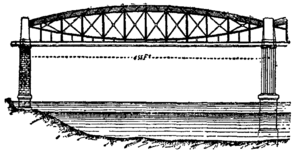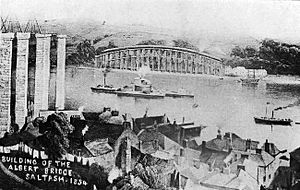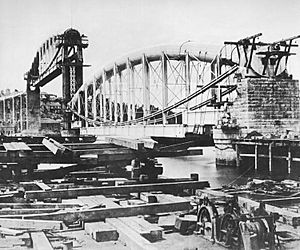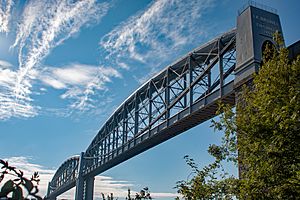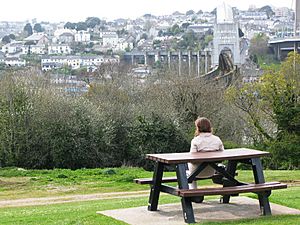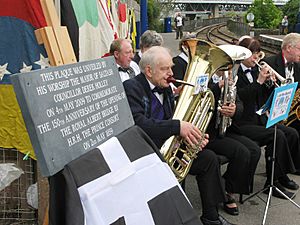Royal Albert Bridge facts for kids
Quick facts for kids Royal Albert Bridge |
|
|---|---|
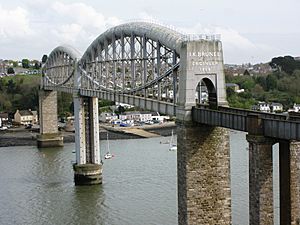 |
|
| Coordinates | 50°24′27″N 4°12′12″W / 50.4076°N 4.2034°W |
| Carries | Railway |
| Crosses | River Tamar |
| Locale | Between Plymouth and Saltash, United Kingdom |
| Maintained by | Network Rail |
| Heritage status | Grade I listed |
| Characteristics | |
| Design | Lenticular truss |
| Material | Iron |
| Total length | 2,187.5 feet (666.8 m) |
| Width | 16.83 feet (5.13 m) (inside piers) |
| Height | 172 feet (52.4 m) |
| Longest span | 2 of 455 feet (138.7 m) |
| Number of spans | 19 |
| Piers in water | 3 |
| Clearance below | 100 feet (30 m) |
| History | |
| Designer | I K Brunel |
| Construction begin | May 1854 |
| Construction end | April 1859 |
| Opened | 2 May 1859 |
The Royal Albert Bridge is a famous railway bridge in England. It crosses the River Tamar, connecting Plymouth, Devon with Saltash, Cornwall. This bridge has a very special design. It uses two large iron sections shaped like lenses, which are 100 feet (30.5 m) above the water.
The bridge was designed by a brilliant engineer named Isambard Kingdom Brunel. Work on the bridge started in 1854. The first big section was put in place in 1857. The whole bridge was finished and opened by Prince Albert on May 2, 1859. Brunel sadly passed away later that year. His name was then added to the bridge as a memorial. Over the years, parts of the bridge have been made stronger. Many people visit the bridge and it has appeared in paintings, photos, and even on a UK £2 coin!
Contents
Building the Railway to Cornwall
In the 1830s, there were two ideas for building a railway to Falmouth, Cornwall. One idea was an easier route around Dartmoor. The other was a "coastal" route. This coastal route was harder to build. But it would serve important towns like Devonport and the industrial area near St Austell.
The Cornwall Railway company wanted the coastal route. They asked for permission in 1845. But their plan was rejected. This was partly because it involved carrying trains across the water on a ferry. So, Isambard Kingdom Brunel took over as the engineer. He suggested building a bridge at Saltash instead. This new plan was approved in 1846.
The Bridge's Special Design
The Royal Albert Bridge was one of three large iron bridges built in the mid-1800s. Brunel learned from the first two bridges, which were designed by Robert Stephenson. Brunel's bridge uses a unique design for its two main sections. It's a bit like the Chepstow Railway Bridge he built earlier. That bridge also had a main section with a curved top and smaller sections on the sides.
The River Tamar is about 1,100 feet (340 m) wide at Saltash. Brunel first thought about a wooden bridge. But the Admiralty, who looked after the rivers, said no. They wanted more space for ships to pass. Brunel then suggested a single-track iron bridge. This would have one very long span. But it would have been too expensive.
So, Brunel came up with the final design. It has two main spans, each 455 feet (138.7 m) long. These spans are 100 feet (30.5 m) above the water. The Admiralty and the railway company approved this plan.
The two main spans are shaped like lenses. The top part is a strong curved tube. The bottom part is made of chains. These parts work together to keep the bridge stable. This design means the bridge doesn't push sideways on its supports. This was important because the railway tracks curve on both sides of the bridge. There are also 17 shorter sections on the land, called approach spans. The whole bridge is 2,187.5 feet (666.8 m) long.
Building the Giant Bridge
The first step was to study the river bed. In 1848, a large iron cylinder was placed in the Tamar. Workers could go inside it to dig and find solid ground for the bridge's foundations. Brunel used this cylinder to make 175 holes in the river bed. This helped him understand where to build the main supports.
In 1853, a company led by Charles John Mare was chosen to build the bridge. They had built parts of the Britannia Bridge. But Mare's company went bankrupt. So, Brunel's team had to finish the first main section themselves. Another company then took over the rest of the work.
Mare's company first set up a building area on the Devon side of the river. They built a large iron cylinder, 37 feet (11.3 m) wide and 90 feet (27.4 m) tall. This cylinder was launched into the river in 1854. It was used to build the central support for the bridge. Once it was in place, the water was pumped out. Workers then built a strong stone pier inside it. This was finished in 1856.
The smaller sections on the Cornish side were built in 1854. Then, the first main section for the Cornwall side was built. It was floated into place on September 1, 1857. Then, it was slowly lifted up as the piers were built underneath it.
Next, the main section for the Devon side was built. It was floated into position on July 10, 1858. It was lifted in the same way and was in its final spot by December 28, 1858. After all the main parts were in place, the railway directors checked the bridge by train in April 1859.
The bridge was also tested by Colonel Yolland for the Board of Trade. He ran a heavy train over it. He found that the bridge moved only a tiny bit, which was "highly satisfactory."
The Grand Opening
Prince Albert agreed to have the bridge named after him in 1853. He was also invited to open it. On May 2, 1859, he traveled from Windsor on the Royal Train. Thousands of people came to watch. Brunel was too ill to attend, so his assistant, Robert Brereton, represented him. The bridge opened for public use on May 4, 1859.
How the Bridge Changed Over Time
After Brunel passed away in 1859, the railway company decided to honor him. They added the words I.K. BRUNEL, ENGINEER, 1859 in large metal letters on both ends of the bridge. For a while, platforms covered these letters. But in 2006, Network Rail moved the platforms so Brunel's name could be seen clearly again.
In 1892, the railway tracks on the bridge were changed. This was part of a big project to make all the tracks on the Great Western Railway the same width.
Over the years, the bridge was made stronger. In 1905, new cross-girders were added for heavier trains. In 1908, two sections near Saltash railway station were replaced. The other approach sections were replaced in 1928 and 1929. More bracing was added in the 1930s to keep the bridge strong.
The bridge became a Grade 1 listed building in 1952. This means it's a very important historic structure. In 2011, Network Rail started a big project to fix up the bridge. They replaced many bolts and added new steel. The bridge was also repainted in its original grey color.
Where to See the Bridge
You can cross the Royal Albert Bridge by train on the Cornish Main Line. From the train, you get great views of the Tamar River. There are also boat tours that go near the bridge. Here are some good places to see the bridge:
- Saltash railway station (50°24′26″N 4°12′33″W / 50.40719°N 4.20924°W)
* The bridge's sections start right at the station platform.
- Saltash Quay (50°24′28″N 4°12′22″W / 50.40779°N 4.20614°W)
* You can walk right up to the main part of the bridge from here. There's a special stone nearby that remembers the bridge.
- Tamar Bridge (50°24′28″N 4°11′59″W / 50.40777°N 4.19974°W)
* The road bridge runs next to the railway bridge. There's a path on the road bridge where you can get a close look at the Royal Albert Bridge.
- Saltash Passage, St Budeaux (50°24′21″N 4°12′02″W / 50.40585°N 4.20069°W)
* You can reach the Devon side of the bridge from the waterfront here.
The Bridge's Big Impact
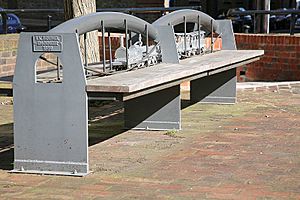
When this huge and unique bridge was built, it quickly became famous. About 20,000 people came to watch the main sections being launched and the bridge opening. Many photos, paintings, and postcards have featured the bridge.
Guidebooks from the time called it "a labor of Hercules" and said its design was "unrivalled in the world." Even today, it's in many travel guides. The writer John Betjeman said that seeing the bridge from the train was a "surprise" and "exciting."
The bridge has become a symbol of crossing from Devon into Cornwall. Some people felt that crossing the bridge was like entering a different, "un-English" place.
Celebrating the Bridge
Special events have been held to celebrate the bridge over the years:
- 1859: Prince Albert officially opened the bridge. He arrived by a special train and then left on the Royal Yacht.
- 1959: The bridge was lit up with floodlights to celebrate its 100th birthday.
- 2006: To celebrate Isambard Kingdom Brunel's 200th birthday, the platforms covering his name on the bridge were moved.
- 2009: For the bridge's 150th anniversary, there were many special events. These included guided walks across the bridge and a re-enactment of the opening day.
See also
 In Spanish: Puente Royal Albert para niños
In Spanish: Puente Royal Albert para niños


